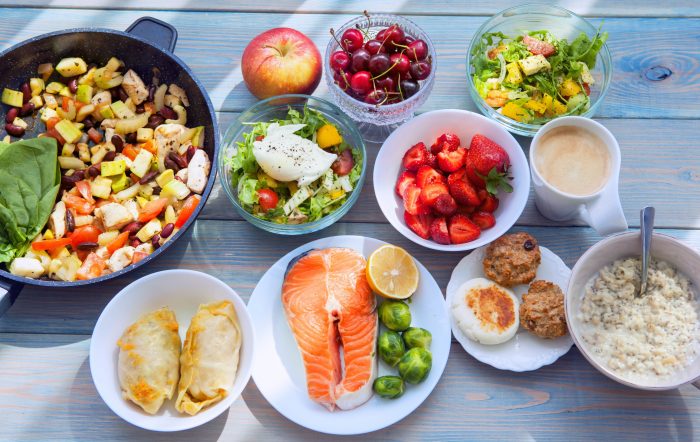A bit of a change of theme in today’s new blog, where we’re taking a look at the topic of weight-loss – a popular request we get here on SquashSkills from those players out there who are looking to shift a little of the excess bodyfat that they’ve accumulated somewhere along the way!
Squash is a sport based very much around speed, endurance, and movement. World-class level players are elite athletes, putting themselves through brutal training sessions to be as streamlined and efficient as possible. It’s crucial in the upper echelons of such a physical sport that an optimal power to weight ratio is maintained, and no unnecessary bodyweight is being carried.
The average club player of course, is highly unlikely to have access to the same training time and facilities to be at the same physical level as a top squash professional. Maintaining a healthy weight however, will go a long way to help ensure that the amateur player can still remain smooth and economical in their on-court efforts.
So what is the best way for the squash player carrying a few extra pounds to trim away that excess body fat and get themselves into peak court condition?
 The foundation of any weight loss programme, will always be a good diet. The old adage ‘you can’t out-train a bad diet’ is a sound one; any training programme that is undertaken with the goal to cut bodyfat, must be combined with a tidy up in diet and an adjustment in the total amount of calories being consumed.
The foundation of any weight loss programme, will always be a good diet. The old adage ‘you can’t out-train a bad diet’ is a sound one; any training programme that is undertaken with the goal to cut bodyfat, must be combined with a tidy up in diet and an adjustment in the total amount of calories being consumed.
Despite what fad diet proponents and supplement manufacturers will tell you, much of adopting a ‘good diet’ is really just based around common sense. Taking in too many calories, more than you burn off through basic daily function and sport/exercise, will result in weight gain.
Reducing calorie intake to find a balance between the energy that is taken in and the energy that is expended, is at the root of weight loss.
There are some good ‘calorie tracker’ apps out there such as MyFitnessPal, for those looking for a good way to be very exact with their monitoring. Just taking more notice of what you eat, how much you eat, and how often you eat is a great start however – keeping a food diary in the same way as you would a training diary can be a very useful tool here. Seeing all that you eat (and drink!) laid out in front of you in writing over the course of a couple of days, can be quite the wake up call!
All macronutrients contribute to your calorie intake, and none are really either inherently ‘bad’ or inherently ‘good’, all have their own role to play within the body – even saturated fat, long demonised as the bad guy of nutrition, has now been shown to have some necessary function within the body (although it’s important to note that fat does contain more calories per gram than any other nutrient, even the ‘good’ fats such as those found in nuts, seeds, and fish). A good balanced diet will consist of foods from all of the major food groups, with a whole range of nutrients being consumed.
Something very much in vogue at the moment are low carb diets for fat-loss. Even ignoring the lack of robust evidence underpinning their validity, simply eliminating carbs (or any single macronutrient) is not a realistic long-term plan for most people, and is not really something that is going to be maintainable over time. A further issue with carb depletion diets specifically, is the removal of the body’s prime fuel source – a particularly pertinent concern for the squash player.
Certainly ‘simple carbs’ are something most people could do with eating less of though, and reducing intake of cheap refined sugars such as the high-fructose corn syrup typically found in sweets and cakes will be a good first step in any healthy diet regime. Excess sugar intake contributes a lot of ‘empty’ calories to our diets, and can have other knock-on health effects in our bodies.
Low-carb proponents do usually also espouse the consumption of more protein though, which is a good thing for the squash player looking to clean up their diet and cut the belly down. Quality protein sources such as lean meats, fish, nuts/seeds, and dairy products are vitally important to the growth and repair of muscles, and are also very useful to those trying to cut calorie intake due to their satiating effects on hunger.
Any set ‘diet’ that you decide to follow is by its very nature short-term – changes in nutritional habits should be sustainable long-term, else any weight-loss achieved will be quickly piled back on when things return to normal. This is often compounded by the ‘yoyo effect’, where frequent dieters see their weight bounce up and down, each time creeping that little bit higher, and making long-term weight loss even tougher. Studies have shown that the majority of people that go on a specific set ‘diet’ and lose weight, are extremely likely to put much (or all) of the weight back on as soon as they go back to a normal eating regime.
So just using common sense and thinking about your diet a little more, whether that be through tracking calories and recording what you eat, or by just generally tidying things up a little by reducing obvious things such as sugar and alcohol intake, is the first step on the road to weight loss. It doesn’t necessarily have to be a massive revolution, but sensible changes do have to be made, and honest attention paid to known problem areas.
The second part of the weight-loss puzzle then, is your physical training. Studies have shown that solid nutritional habits COMBINED with a good exercise programme are the best key to unlocking a sustainable reduction in body fat.
 The repeated bursts of high intensity efforts such as those which the body is subjected to in a game of squash, are actually a great route to calories burning in themselves. ‘Interval training’ (often known as ‘HIIT’, or ‘high intensity interval training’) is a popular and well-established modality of exercise, where a workout is scheduled around lower paced activity interspersed with very high intensity efforts – this method of training has been shown to provide a maximal fat burning effect, and an increased metabolic rate that can last for over 24 hours after training.
The repeated bursts of high intensity efforts such as those which the body is subjected to in a game of squash, are actually a great route to calories burning in themselves. ‘Interval training’ (often known as ‘HIIT’, or ‘high intensity interval training’) is a popular and well-established modality of exercise, where a workout is scheduled around lower paced activity interspersed with very high intensity efforts – this method of training has been shown to provide a maximal fat burning effect, and an increased metabolic rate that can last for over 24 hours after training.
For many years however, recommendations for losing weight were based around longer, slower, steady paced aerobic exercise, in pursuit of the famous ‘fat burning zone’. While it’s true that working at a more moderate pace may burn a higher relative PERCENTAGE of fat than other fuel sources, the TOTAL calories burnt in an interval based workout will be higher – including more fat overall. That, along with the contributions of the aforementioned ‘after-burn’ effect, makes interval training the best route for those looking to burn off excess body fat.
So if intervals are such a good method for weight loss, why is not just playing more squash and eating a good diet the best recommendation for the player looking to cut down their body fat?
One reason squash players can struggle to lose weight from just their standard on-court efforts, stems from the limitation that their excess weight places on them. Carrying additional weight places a lot more strain on the joints and muscles of the body – squash is a very high impact game, so being too overweight can really limit the speed and intensity of movement a player is capable of, and thus prevent them from being able to work sufficiently hard to properly elevate the heart rate and really kick start the calorie burning process.
The human body is also very good at settling into a state of homeostasis, where it will attempt to expend the smallest amount of energy for any given task. Just the simple act of introducing a new physical stimulus in the form of some dedicated fat-burning training and breaking away from your standard on-court match/training efforts, can really help act as a catalyst to start expending more calories and cutting some of that stubborn stored body fat.
Gary Nisbet
B.Sc.(Hons), CSCS, NSCA-CPT, Dip. FTST
Squashskills Fitness & Performance Director
Get your warm-up right!
Warming-up is a crucial part of your training to help optimise performance, and prevent injuries. Check out our excellent FREE warm-up guide to help make sure you’re primed and ready for your session!
Download your FREE Warm-Up Guide!